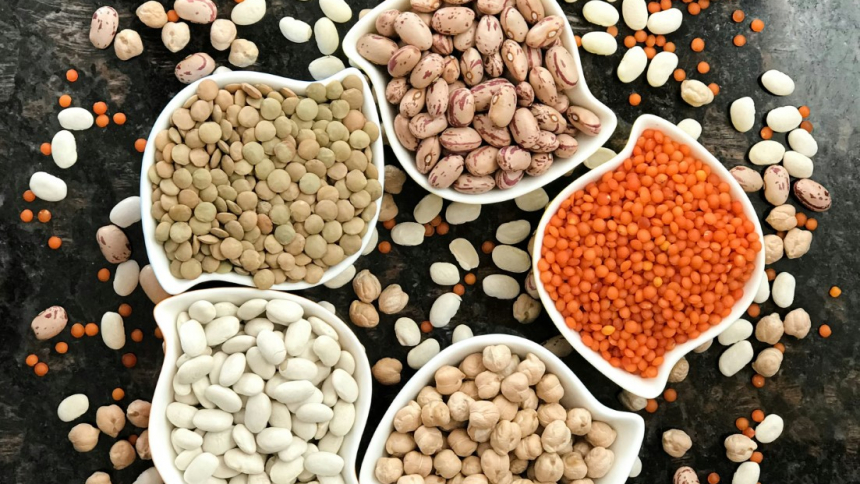
A study by the Grains and Legumes Nutrition Council found only a quarter of Australian adults reported eating legumes, which include beans, peas and lentils.
Do you get enough of them in your diet? Perhaps you don’t know enough about them or how to cook with them. Let’s take a closer look at legumes.
Do you have enough of them in your diet? Perhaps you don’t know enough about them or how to cook with them. Let’s take a closer look at legumes.
They are a broad family
Legumes belong to the fabaceae or legumionsae family, the third largest family of flowering plants with more than 20,000 species. A legume is defined by a seed pod that typically splits down two sides and the unique root nodules that enable it to convert nitrogen gas into a form the plant can use to grow.
While the term is often used interchangeably with pulses and beans, legumes are actually the entire plant – leaves, pods and stems. The pulse is the edible part of the plant, though it gets confusing as we can consume the entire pod of some legumes, such as peas, snow peas and green beans.
Other common legumes, often bought in cans, include cannellini beans, chickpeas and red kidney beans. Then there are black beans, black-eyed peas, edamame (young soybeans), fava beans, lupin, pinto beans, soybeans and split peas.
Peanuts are also part of this large family. While the name might tempt you to lump the nuts in with almonds, cashews and walnuts, they are not part of the same family. Unlike the other nuts which grow on trees, peanuts grow from pods underground.
They are very good for you
Legumes are full of goodness, including protein, fibre, iron, vitamin B, folate, calcium, potassium and zinc. They are also low in fat and don’t contain cholesterol.
They have a lower GI than other sources of carbohydates, lowering blood sugars. This can help prevent or manage conditions such as type-2 diabetes, hypertension and cholesterol.
They are also rich in antioxidants that can lower the risk of stroke and cancer. Even if you don’t follow a vegetarian diet, substituting some meat with legumes can lower blood pressure and inflammation, two risk factors for heart disease.
Green beans and snow peas tend to have less protein and carbohydrates than dried beans, but are higher in water and fibre.
Legumes also make you feel fuller for longer, reducing the temptation to snack between meals and helping to keep weight under control.
Some people can get stomach upsets, flatulence or indigestion from eating legumes but that is generally due to a diet low in fibre. Start adding legumes gradually, such as a few kidney beans in a taco sauce, and increase as your body adjusts.
They are available all year round
Whether you prefer them dried, or in cans or jars, legumes are readily available throughout the year.
If you prefer to use dried legumes, you will need to store them in a cool dry place to keep them fresh. Most dried beans will need to be soaked, often overnight, before they can be cooked. Rinse them thoroughly, and then cover with water. When ready to use them, drain the water and add to your favourite dish as per instructions. They can take between 30 minutes and two hours to cook, depending on the recipe.
Jars or cans are very convenient and just as good for you, providing they are not overladen with salt. Check the sodium content on the ones you buy and choose low-sodium options. If you give them a good rinse before cooking, you can also reduce the amount of salt.
They can be added to almost anything
Legumes are a staple diet around the world, from India – think creamy, spicy lentil dahl – to the Mediterranean, where Italian kale and cannellini bean (ribollita) soup is one of many popular dishes.
They are easy to cook with and very versatile. Start your day with a luscious lupin porridge, adding your favourite fruit, or make your own granola to have throughout the week. Whip up a lupin dip to have with crackers or sliced vegetables later in the day.
Add them to soup or spicy dishes, such as this chickpea and pumpkin laksa, or blend a tin of chickpeas with some lemon juice, garlic and cumin seed for a delicious homemade hummus.
Fresh legumes really pop in stirfries and salads, such as this snowpea, broccolini and avocado fiesta of green, or a simple side dish such as green beans and bacon.
Brown, red or puy lentils are great in soups, stews and salads, such as this simple recipe which marries lentils, celery and fresh herbs with Creamy Suzette cheese from Halls Dairy.
Soybeans are more commonly consumed as tofu, but the younger edamame beans are also great in salads and make a lovely dip to go with fish or meat, while black beans add a little oomph to this lovely lamb dish.
Whether you’re a lifelong lover of legumes, or slowly introducing them to your cooking roster, there are so many ways to enjoy them. They are a great part of any healthy diet.